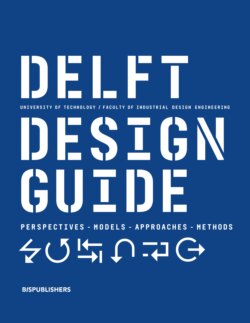Читать книгу Delft Design Guide -Revised edition - Annemiek van Boeijen - Страница 40
На сайте Литреса книга снята с продажи.
ОглавлениеWhat & Why? Drawing represents an early sign of culture, an expression of mankind’s unique creative capabilities and an example of our near-exclusive usage of tools. The activity of drawing or scetching has characterised human beings since prehistoric times: it was utilized for communicating long before writing was present and served as a basis for written language.
Drawing supports a range of methods and creativity in general in all stages of the design process. Visualisation helps externalise our thoughts. It serves aesthetic, behavioural, cognitive, and communicative purposes. In a design context, sketching serves these four purposes with a focus on collaboration, cognitive development, and communication. Drawing is a method for developing knowledge, thoughts, concepts, ideas and for communicating these with others such as peers and clients. Use it to discuss or present concepts, or to provoke a reaction. Sketches convey information and provide signature.
The word ‘sketching’ literally meanis ‘improvise’, which characterises the dynamic and developmental function that it has in a design context. The creation, preservation, and transfer of knowledge have always been important functions of drawing and sketching. Especially for designers sketching constitutes an essential asset for their visual language, which is akin to writers using text for communication.
---------------------------------------------------------------------------------------------------------------
Mindset: Feel free to use any technique, drawing tool or other means at your disposal to to visualise your observations and thoughts.
How? Artist and painter David Hockney stated that with drawing you can express all kinds of ideas that might otherwise be lost. Art critic John Ruskin said that the discipline of drawing tunes the sensitivity of the drawer to a higher pitch; it refines the drawer’s vision.
Sketches can be representations of either existing things and situations or of conceptual thoughts and imaginary concepts. This limitless medium allows for exploring and creating visions and scenarios that can involve anything.
Designers draw throughout the entire design process. The appearance of the sketch or visual
representation differs according to its purpose. Various factors are involved, such as the designer’s intention, the subject or field, the audience, the type of decision to be made, the direction of the information flow, and the stage of the design process.
The four design stages of Discover, Define, Develop, and Deliver (the Double Diamond Model) are taken as a starting point for distinguishing the various process parts for sketching. These stages and the ways in which sketching and visualising can contribute to the stages are discussed in the subsequent sections of this book.
Design Drawing as a Language
References & Further Reading: Eissen, J. J., & Steur, R., 2009. Sketching . Amsterdam: BIS Publishers. / Robertson, S., & Bertling,
T., 2013. How to Draw . Design Studio Press. / Tversky, B. (2011). Visualizing Thought. Topics in Cognitive Science , 3(3), 499-535. /
www.delftdesigndrawing.com/basics.html
Tips & Concerns
Utilize a drawing language that emphasises a well-considered structure, viewpoints and composition using clear lines and tonal values, both for concrete and for abstract representations .
--------
Sketching requires practice in order for us to use the full potential the method offers.
--------
Start by drawing basic shapes, and then slowly increase the complexity and creative exploration while practising motor skills and raising your awareness of perspective and composition.
--------
Maintain and improve your skills; sketch every day!
--------
See also: Design Drawing in the four stages of this book.
--------------------------------
Limitations
In later stages, alternative formats come into play, such as graphic design, movies, animations, and CAD renders, which usually need to be preceded by sketches as well.
Throughout the entire design process, design drawing can serve as a visual language for exploring options and communicating final or intermediate outcomes. Drawing can facilitate thinking, boost creativity, kick-start conversations, and explain concepts. Drawing can be done on paper or a tablet; it offers flexibility and adds the designer’s signature to a proposal, and it is universally understood.
perspectives
---------------------------------------------------------------------------------------------------------------------------------------------------------------
---------------------------------------------------------------------------------------------------------------------------------------------------------------
39
